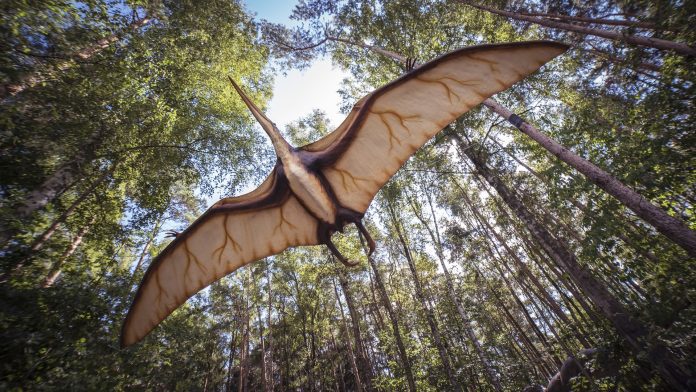Fossil of a 170-million-year-old pterosaur, the largest flying dinosaur of its era, discovered in Scotland. jaw peeping from limestone shoreIsle of Skye, Scotland Scientists Led to FindCheleton of a pterosaur Which showed that these remarkable flying reptiles grew up millions of years earlier than previously known. The researchers explained that pterosaurs, called dierk sagiathanach, lived almost 170 million years ago during the Jurassic period, flying over a lagoon in a subtropical landscape and catching fish and squid thanks to their crossed teeth, perfect for catching even the most slippery prey. Its scientific name, pronounced “Jerk schee-ee-h”, means “winged reptile” in Gaelic.
Scotland’s largest flying dinosaur fossil found
with’approx 2.5 m. wingspan ofdierk was The largest known pterosaur of the Jurassic and the largest flying creature on Earth Till that moment. During the later Cretaceous period some pterosaurs reached very large sizes – as large as fighter jets. But Dierk shows how this growth originated much earlier. By analyzing its bones, scientists understood that the specimen had not yet reached adulthood and it could have gotten even more feathers, “Dierk also weighed very little — perhaps less than 10 kilograms — thanks to its hollow, light bones and lean frame,” said University of Edinburgh Paleontology graduate student Natalia Jagielska, lead author of the research published in the journal Current Biology. It had a long skull and a long, stiff tail. An arsenal of fangs made a cage when biting its prey. Pterosaurs that lived with dinosaurs were the first of three vertebrate groups to fly, was visible about 230 million years ago. Birds appeared about 150 million years ago and bats about 50 million years ago. Pterosaurs are some of the rarest vertebrates in fossils because of their brittle bones, some with walls thinner than a sheet of paper.
“Our sample is an anomaly because things like this don’t usually happen. Pterosaurs are usually flattened because they’re so fragile, and very rarely preserved.Jagielska said.
When did these flying dinosaurs appear?
By the time Dierk lived, pterosaurs were generally modest in size, with many being the size of a seagull. The prevailing hypothesis among scientists until this discovery was that pterosaurs did not reach critical size until the Cretaceous, about 25 million years later, when organisms such as Huanhepterus, Phyllongus, and Elanodactylus appeared. Appearing about 68 million years ago, Quetzalcoatlus boasted a wingspan of about 11 metres, similar to that of an F-16 fighter.
In Dierk’s time, Britain was closer to the equator And it existed as a chain of separate small islands. Dierks lived alongside herds of omnivorous dinosaurs, mammals and marine reptiles. its fossil remains were Discovered thanks to a bone that emerged from a quiet intertidal zone Opened at low tide. Researchers first extracted the fossil using hammers and chisels and then diamond-tipped saws, but it took time to fully extract the skeleton. Researchers also had to contend with the return of high tides:
“We almost lost it when the tide came out again and we had to go back around midnight to get it back. Luckily it was still there” Study co-author Steve Brusatte said.

Devoted problem solver. Tv advocate. Avid zombie aficionado. Proud twitter nerd. Subtly charming alcohol geek.







